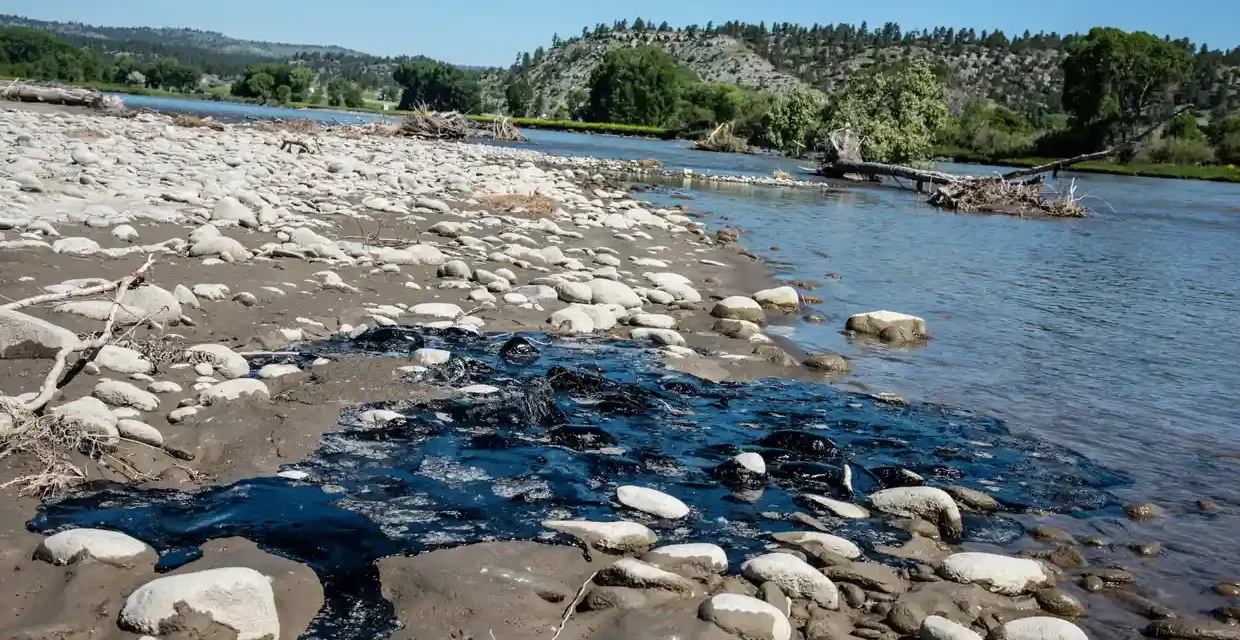In response to a bridge collapse and train derailment near Montana’s Yellowstone National Park, the Environmental Protection Agency (EPA) has taken immediate action to commence cleanup operations to address the spillage of toxic chemicals into the Yellowstone River.
Eyewitnesses have reported the presence of hazardous globs of asphalt binder scattered across islands and riverbanks downstream from the spill site, raising concerns about the environmental impact on this vital waterway.
In collaboration with other involved entities, the EPA has swiftly initiated efforts to mitigate the damage caused by this unfortunate incident.
Cleanup operations officially began on Sunday, with workers from the EPA actively engaging in the meticulous process of cooling down the sticky substance using river water.
The cooled asphalt binder is subsequently rolled up and collected in designated garbage bags.
EPA representative Paul Peronard has confirmed that recycling the collected material is the intended course of action, reflecting a commitment to sustainable cleanup practices.
Alarming photographs captured by Alexis Bonogofsky, whose family previously experienced an oil spill in the same river back in 2011, illustrate the extent of the contamination.
Rocks and sandbars coated in refined petroleum products serve as a stark reminder of the devastation caused.
Bonogofsky’s documentation also includes a heartbreaking image of a killdeer bird tragically perished with its head embedded in the hot asphalt.
The distressing photographs serve as a poignant reminder of the urgent need to address the aftermath of this incident.
The incident occurred on June 24 when a bridge over the Yellowstone River collapsed while a train was in transit near the town of Columbus.
Ten train cars plunged into the river, resulting in the spillage of both liquid asphalt and molten sulfur.
While authorities anticipated the sulfur to solidify as it cooled, the behavior of the asphalt binder posed unexpected challenges.
Peronard expressed concern over the peculiar nature of the spilled asphalt binder, which defied expectations by not sinking in the water.
Instead, it adhered tenaciously to rocks and exhibited a consistency reminiscent of taffy when exposed to the sand.
Moreover, Bonogofsky’s photographs captured a telltale sheen on the water’s surface, signaling the presence of the heated spilled material, which emitted a distinctive odor.
Adding to the complexity of the cleanup operation, the Montana Department of Environmental Quality, the EPA, and Montana Rail Link—the entities responsible for managing the aftermath—recently reported an additional release of asphalt product during the removal of a rail car from the river.
Although authorities deemed the release minimal, it highlights the ongoing challenges faced in tackling this environmental crisis.
Authorities have urged the public to promptly report any sightings of asphalt materials on the riverbank via email to rpderailment@mtrail.com.
Additionally, a dedicated phone line (888-275-6926) operated by the Oiled Wildlife Care Network has been established for reporting animals affected by the spill.
As of now, no reports from the public regarding sightings or affected wildlife have been received, according to Peronard.
However, Bonogofsky criticized the delay in formulating a comprehensive cleanup plan, emphasizing the importance of preparedness based on prior incidents such as the 2011 oil pipeline spill.
She argued that addressing the cleanup of the asphalt binder could have been conducted concurrently with the removal of the rail cars from the river, thereby expediting the process.
Peronard indicated that the final rail cars are expected to be successfully removed from the water by Sunday.
Subsequently, agricultural users have been notified that they may resume utilizing river water for irrigation after temporary shutdowns as a precautionary measure.
Cleaning up spills of petroleum products presents a daunting challenge, with Peronard acknowledging the inherent difficulty in fully recovering all of the spilled material. Despite the best efforts, some residual impact is expected even after the completion of the cleanup.
Nevertheless, Peronard emphasized the EPA’s commitment to prioritizing human safety, controlling the source of the spill, and minimizing harm to the environment.
The cleanup plan remains cautious not to disturb the nesting areas of birds and turtles in the vicinity, with strict regulations stipulating that cleanup crews must maintain a minimum distance of half a mile from eagle nests.
It is crucial to note that the spilled asphalt binder is not water-soluble, according to Peronard, further complicating the cleanup process.
The EPA and other involved entities are diligently working to resolve this environmental emergency, focusing on both the immediate mitigation of damage and the long-term recovery of the Yellowstone River ecosystem.
Photo: Alexis Bonogofsky / AP










